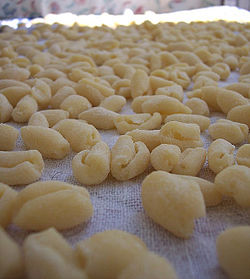Top Qs
Timeline
Chat
Perspective
Cavatelli
Type of pasta From Wikipedia, the free encyclopedia
Remove ads
Cavatelli[a] are small pasta shells made from semolina or other flour dough,[4][5] commonly cooked with garlic and broccoli or rapini, or simply with tomato sauce. A variant adds ricotta cheese to the dough mix.[5]
Many varieties and local names of cavatelli exist, including gnocchetti, manatelli, orecchie di prete (lit. 'priest's ears'),[6] strascinati, truoccoli; capunti, cingule, minuich, rascatelli, zinnezinne (Basilicata); cantaroggini, cavatieddi, cecatelli/cicatelli, cecatidde, cortecce (lit. 'tree barks', Salerno),[7] mignuicchi, strascenate, tagghjunghele (Apulia and Campania); pincinelle (Marche); cavatielle, 'ncatenate, cazzarille, ciufele (Molise); cavasuneddi, cavatuneddi, gnucchitti, gnocculi (Sicily),[8] and pizzicarieddi (Apulia).[6][9]
A particular variety of cavatelli is typical of the comune (municipality) of Teggiano, in Campania, where they are referred to as parmitieddi. Parmitieddi are larger than cavatelli and flat-shaped. They are obtained by rolling a stick dough with three fingers of one hand, instead of with a single finger as done for the common cavatelli. Parmitieddi are usually served as a first course on Palm Sunday because their shape, similar to that of a tree leaf, recalls that of a palm.[6] In Campania, they are most common in the city of Benevento.[10]
Cavatelli with a softer texture are produced by boiling water before it is added to flour.[10]
Remove ads
Gallery
- Cutting cavatelli into pieces
- Dry capunti, a variety of cavatelli from Apulia
- Cavatelli for sale
- A dish of cavatelli
See also
![]() Media related to Cavatelli at Wikimedia Commons
Media related to Cavatelli at Wikimedia Commons
Notes
- English: /ˌkævəˈtɛli/ KAV-ə-TEL-ee, US also /ˌkɑːv-/ KAHV-,[1][2][3] Italian: [kavaˈtɛlli]; lit. 'little hollows'; cognate to English cave and cavity.
References
Further reading
Wikiwand - on
Seamless Wikipedia browsing. On steroids.
Remove ads





